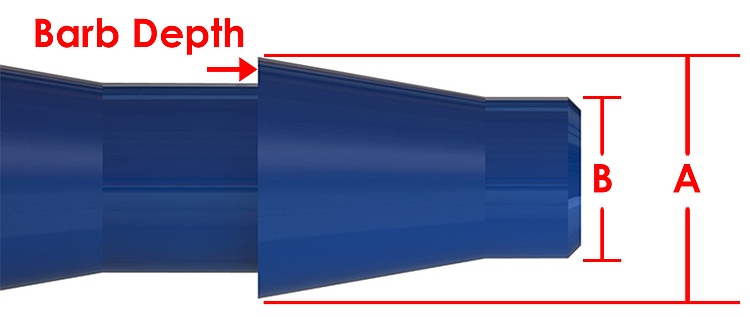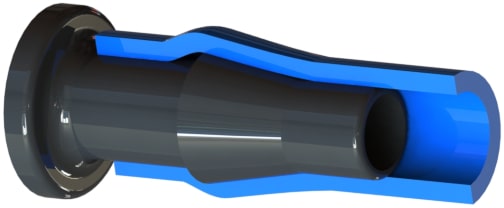Design and Function of Hose Barbs - General Info: Not Just Brass Fittings!
Created at :
Sep 14, 2020
BARB CONNECTORS IN DEPTH – DESIGN AND FUNCTION
Reference: https://www.industrialspec.com/about-us/blog/detail/barb-connectors-in-depth-design-and-function
Assorted plastic hose barb styles
Barb connectors have become one of the most common miniature flow control components because of performance and value
An introduction to barb connectors
Barbed fittings, frequently called hose barb or hose barbed connectors, are one of the most common flow control components because of their convenience, reliability, performance and excellent value. Uses range from garden hose adapters to biopharmaceutical process system connections.
Despite their widespread use, the how and why of barb design and the resulting range of functions and technical effects are not always well understood.
This blog post looks at the design of barb connectors in some detail. It focuses on barb connector functions, how barb design affects performance and includes some tips for choosing a suitable hose barb fitting.
What is a hose barb?
A barb connector or hose barb is the section of a fitting or component connected to a piece of hose or tubing by being inserted into that hose or tubing. A somewhat wordy but useful description of a barbed connection is “a connection made and held in place by one or more continuous radial serrations or ridges surrounding a hollow tube through which fluid and air flow can take place.”
MODULAR CHECK VALVES
Barbed fittings are widely used in low pressure (about 200psi or lower) fluid, gas and air flow control applications. The barb serration or ridge grips the interior wall of the tubing and provides a sealing surface without damaging the tubing wall. How barb surfaces interact with a hose or tube’s inner surface determines how well barb connectors function and their suitability for any particular application.
Barb connectors – their functions and benefits
- Create a seal between the tubing and the fitting
- Cost-effective, high value system component options
- Provide simple, easy and fast hand installation and maintenance
- Come in a variety of materials which helps with chemical compatibility
- Provide hose and tube connections that are highly blow-off and pull-off resistant
Get more insights into plastics and Chemical Compatibility.
MCBJ series male NPT thread by
hose barb tube connector
in natural Kynar® plastic.
Barb design factors that affect grip and seal quality
- Barb angle
- Parting lines
- Surface finish
- Sharpness of the barb relative to the hardness (durometer) of the tubing
Get more insights into Plastic Hose Barb Styles and the design reasoning behind them.
A too-sharp barb edge can cut a too-soft hose or tube. The manufacturing process may leave parting lines on the barb edge or tapered barb surface. It is possible these can provide a leak path. Choosing a good barb profile delivers a better seal by providing good sealing surfaces on the inner wall of the tubing.
Barb profile
The design of a barb profile also determines how much a hose or tube stretches when pushed over the barb. This can determine how easy or difficult it is to install the hose or tube on the connector. A hose or tube must stretch in order to fit over a barb. This stretch is indicated as a percentage of the hose or tube inner diameter (ID). A higher expansion percentage usually causes barb connectors to seal and hold against higher pressure.
Cross section of flexible tubing
pushed over a barb connector.
Blow-off and pull-off resistance
Pulling hose or tube on a barbed connection causes the tubing to contract and grab the barb even tighter. In most cases, this makes it very difficult to accidentally pull a tube off a barb connector. Spikes in pressure on the other hand, can make tubing expand, potentially loosening its grip on the barb.
Reduced blow-off and pull-off resistance is the more likely if there is a mismatch between barb design and the durometer of the hose or tubing. A poor match can cause other problems too. It can make installation and maintenance much more difficult and this can lead to leaking.
Assembly forces
In general, the best choices are usually barb connectors with a barb profile or shape that provides reasonable assembly force plus good grip on the hose or tube. Assembly force and a barb’s ability to grip a hose or tube are directly related to the barb design. The larger the barb angle, the greater the percentage stretch and the more aggressive the barb design. Hand installation is more difficult with a more aggressive barb design but it does provide a greater resistance to both blow-off and pull-off.
BFVX series hose barb by UNF
thread plastic swivel fittings
use a single barb design.
Barb design features that affect a barb connector’s blow-off and pull-off resistance:
- Number of barbs
- Depth of the barb
- Spacing of the barb ridge or ridges
- Sharpness of the barb gripping edge
- Slope or angle of the barb otherwise known as its profile (high vs low)
What is barb depth?
Barb depth is the diameter of the gripping edge compared to the diameter of the shaft behind it. This needs to be a good match for the flexibility of the hose or tubing. If it is a good match, the hose or tubing will relax around the shaft and form a seal. This provides both a better seal and greater resistance to blow-off and pull-off.
 Barb depth and tubing expansion from diameter B to diameter A
Barb depth and tubing expansion from diameter B to diameter A
Barb slope, tubing expansion and leak-proof seals
Installing tubing on a hose barb connection requires pushing the tubing end up the slope of the barb, past the barb’s gripping edge or edges and then back over and along the shaft of the barb. The gripping edge or edges of the barb hold onto the inner surface of the tubing. The expanded tubing or hose relaxes behind the gripping edge or edges adding to the grip and improving the seal.
The barb depth and tubing expansion illustration above shows the three most important parts of a hose barb profile. They determine how well plastic tubing or hose grips the hose barb and how good the resulting seal is.
The first of these is where the tubing inner wall is in contact with the sloped or angled surface of the barb. The second is where the barb gripping edge makes contact with the tubing inner wall. The third is where the tubing relaxes behind the gripping edge or edges. How well the tubing relaxes behind the barb is the most important of the three for a connection that is both strong and leak-proof.
Get more insights into Plastic Hose Barb Styles and the design reasoning behind them.
YJ series barbed “Y” shape hose barb
plastic tube fitting
in natural Kynar®.
What to consider when choosing a hose barb fitting
- Single or multi barb
- Material chemical compatibility
- Inner diameter of the hose or tubing
- Durometer or hardness of the tubing
- Operating conditions (process and environment, think cleaners and sunlight)
Learn more about chemical compatibility can affect plastics and other materials.
A note about fitting customization and barb connectors
Despite the vast array of adapters, fittings and components available with barb connectors, non-standard parts may be the best option. ISM has the capability of providing an incredible variety of customized flow control fittings. The sophistication of our customized fitting and tubing assembly services reflects decades of experience and a keen attention to quality.
Learn more about ISM’s customized fitting and tubing assembly services.
Our fitting customization services are always available when a unique application requires a one-of-a-kind component solution. ISM can also support projects of any size, from a handful of prototype parts to thousands of assemblies. With ISM, application designs are limited only by size constraints and the developer’s imagination.
EMX series male thread by hose barb elbow
uses a multi barb design
Key takeaways about barb connectors
- Work best with softer tubing
- Usually lower cost than many other types of fitting connections
- Can be more difficult to disconnect than push-in (push-to-connect) fittings
- Are a better suited for environments and applications that need to minimize leakage
- Matching tubing to barb is based on the tubing inside diameter (ID) and its durometer
Many component manufacturers have developed, designed and applied their own standards for barb profiles because there are limited industry standards for barb connectors. This can make it more difficult to choose the right barbed connector fitting.
The best approach for picking a hose barb fitting is to choose the right barb profile for the tubing or hose. Then, you should probably test samples of both in real operating conditions. In general, hose barb size will usually need to be the same as the inner diameter (ID) of the hose or tubing. The fitting manufacturer will recommend which hose or tubing durometer to use.
Any hose or tubing used with barb connectors will need to stretch around the barb ridge and then relax back around the cylindrical surface behind the barb to create a good connection. Making the best choice of barb connectors and tubing provides designers with user-friendly, cost-effective system designs and component options.
Now that we have reviewed the above Barb Technology "How they work" Please check out our Brass Hose Barbs - Push-on Hose Barbs - mini barb hose barbs - Single Barb Hose Barbs & More Hose Barbs






